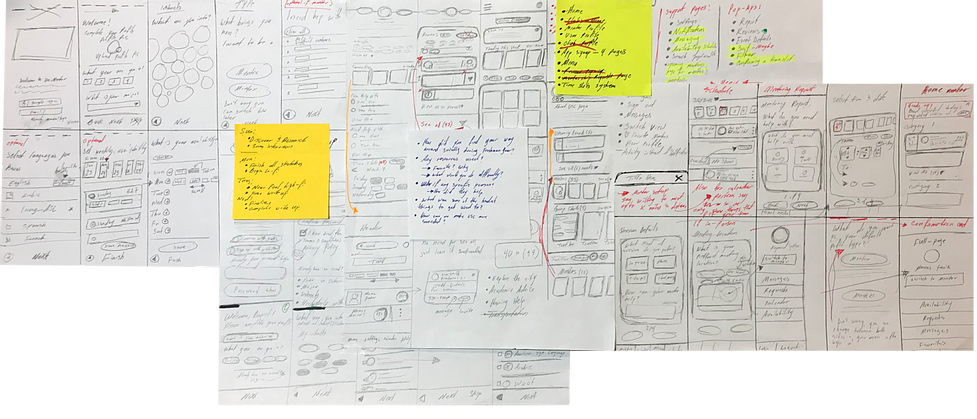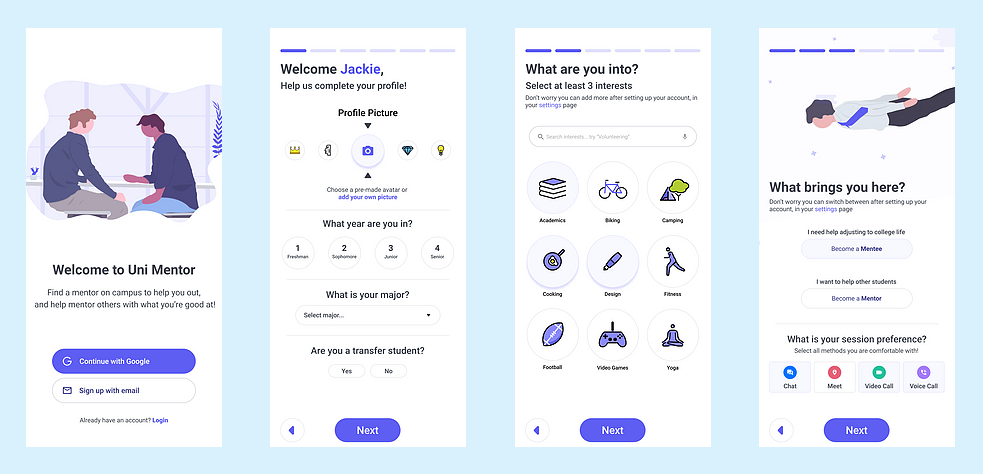
UI/ UX Internship Prompt
Summer 2020
A 7-day design project was assigned to internship applicants who made it past a certain phase. Unfortunately, I was not selected in the end. However, I hope this project gives you an idea of my capacity, even within the constraints of a 7-day timeframe.
Prompt #2 - Mentoring
Your school wants to strengthen the community by encouraging experienced students to connect with new students and help them adjust to campus life. Design an experience that allows mentors and mentees to discover each other. Consider the needs of both mentors and mentees, including how someone may become a mentor and how to connect mentors to mentees.
Something stood out to me…
Consider the needs of both mentors and mentees
- Since the service was not monetized, I focused on how we could benefit the mentor without relying on monetary incentives.
- This aspect was expanded upon through student interviews, which revealed that even senior students occasionally sought mentorship and were willing to forgo monetary incentives in exchange for occasional advice.
My Process

- Discover - Brainstorm and conduct basic online research to gain insights about my users, going beyond my assumptions and formulating research questions.
- Research - Utilize online resources for gathering specific, open-ended questions, and conduct in-person interviews to understand my users’ primary objectives.
- Define - Break down complex tasks into smaller, manageable components.
- Ideate - Create flow maps and sketch out basic breakdowns.
- Design - Start with low-fidelity designs and gradually move towards high-fidelity. Revert to low-fidelity for components or features that require further refinement.
- Test - Gather user feedback to identify areas that need improvement and make necessary changes.
Research
Created a short, 5-question survey to ask students around campus. Keeping in mind the ongoing exam season, I ensured my questions were brief and open-ended, aiming to gain deeper insights into the users’ needs.
Key Insights
After asking 13 students, below are some key insights for each user type:
- Availability - Varies depending on weekly study load, which determines the amount of dedicated time for other activities.
- Communication - Not everyone was willing to freely share their contact information. (7/13 were reluctant about in-person meetings)
- Fit - “Finding someone with similar interests is quite challenging.”
- Familiar Struggle - Transfer students prefer working with other transfer students.
Accessibility
With 1,200 differently-abled students as of 2015, ensuring accessibility was crucial throughout the design process. From running my color choices through Google’s Material Design Color Tool to carefully considering the placement of checkboxes, I prioritized keeping the user at the center of my design thinking.
Early, rough sketches

Onboarding Process

Solving the Availability Problem
With students having diverse schedules, implementing a matching solution was the most effective way to address this issue. By considering availability, interests, and profile preferences, mentees would receive automatic notifications of matches that align with their schedule.
For those who need a faster response, users can directly request invites from available mentors without waiting for approvals from specific mentors. However, certain limitations are in place to prevent abuse.

Takeaways
- Accessibility encompasses more than choosing the right colors; sometimes it involves finding solutions that are less likely without the use of technology, such as connecting with other ASL speakers.
- While something may be more human-centered, it doesn’t necessarily mean it will seamlessly integrate into all design mediums.
Future improvements
- Including an option to assist with navigation would be a valuable addition, helping new mentees find their way to meeting locations on campus and preventing them from getting lost.
- Providing comprehensive support for clubs and communities would be essential if this concept were developed into a full-fledged application. Based on interviews and online feedback, clubs emerged as the top choice for helping students adapt to college life.
Reflection
The exercise was fantastic in the challenges it proposed, from packing an efficient scheduling system to considering the broad user range a university would have.